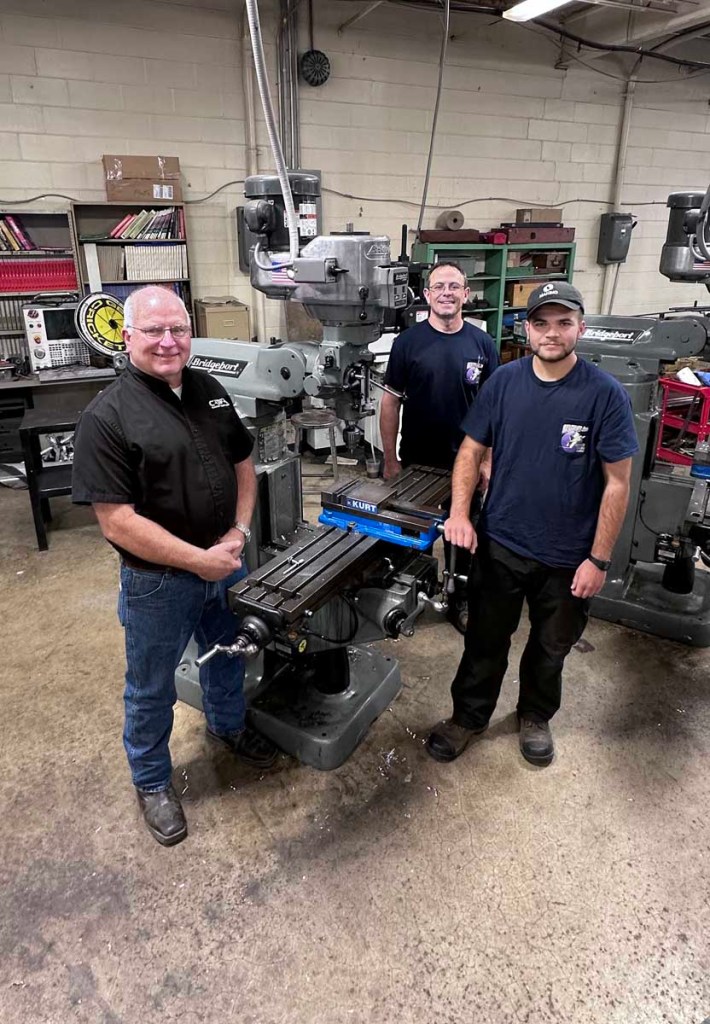They advance humankind: Mach III Inc. owner, employee tout importance of precision machining
Published 12:15 am Tuesday, January 3, 2023

- Cullman Area Technology Academy (CATA) precision machining instructor Tim White, right, Roy Manley, owner of Mach III Inc., center, and graduate and Mach III employee Branden Singleton at in the CATA precision machine shop.
When we look around at the modern world, it can be easy to take the things that surround us — things that have enabled us to live such comfortable lives — for granted.
Some of these things are incredibly high-tech pieces of equipment — such as satellites orbiting the earth — that allow us to quickly and easily communicate with those on the other side of the globe. Some are more simple, such as the concrete blocks that come together to construct the buildings we spend our time in.
Trending
While there may be very few similarities between aerospace engineering and block masonry, both of these items — along with nearly every other man-made item we come in contact with — have one thing in common. At some stage in development, it was the work performed by a machinist that enabled these items to exist.
“Other than human beings, or trees and grass, and all that stuff, everything else that exists a machinist has touched somewhere along the line. If it’s a concrete block, a machinist made the mold for it. Any and everything you can look at is going to start by being manufactured by a machinist,” said Roy Manley, co-owner and vice president of Mach III Inc.
But in contrast to the extent of the contributions the field of precision machining has made for the advancement of humankind, Manley said that a haze of misconceptions continue to surround those in the trade.
“Everybody perceives it as being a mechanic,” he said. “Most people will stereotype mechanics as being all greasy, walking out of this dungeon and crawling up under cars and all that. But the truth is that this is one of the most high-tech fields you will see. As far as putting a man on the moon, a machinist is where it all had to start.”
Cullman Area Technology Academy (CATA) precision machining instructor Tim White said fighting such misconceptions is one of the most difficult obstacles to overcome when recruiting students.
“That’s one of the biggest challenges with getting folks into this program is because the fear of the unknown. … They don’t know what it is. I’ve even had people come up and ask, ‘So what do y’all do? Just work on machines?’ So, they don’t know what’s going on. But, usually if we can get them in there, they don’t want to leave. We’ve even had girls that couldn’t get into cosmetology before, and once they got here they found their niche,” White said.
Trending
What precision machinists actually do is fabricate the individual components that come together to create many of the items we come into contact with each day — from nuts and bolts, to scalpels and surgical equipment, to specialized pieces used in the aerospace industry. Many times, these parts will be used to craft prototype models and are not yet mass produced, meaning that a machinist will need to be able to look at a presented design and create the piece needed with nothing else to go on.
“What we teach these young guys — we tell them until we’re blue in the face — is that you have to have a superpower imagination. You have to be able to imagine what that part is going to look like in your head. We don’t have the technology here yet to make holograms, but your brain will do that. When you look at a print and you understand the top, front, and outside view of that print, you can visualize that part,” White said.
What White and his team in the precision machining department at CATA do is to take students who have very little experience or knowledge about the trade and in a few years equip them with enough skills to continue their education or to enter the workforce.
“Most of these guys that come to us now are in the ninth grade, and some of them literally do not know the difference between a pair of pliers and a screwdriver. So, what we try to do in a couple of years is to give them enough skills to move on to a post secondary program or to enter the workforce. We start out by giving a basic skill set in precision measuring instruments, blueprint reading, and shop math. Then we start out on the manual mills and lathes and toward the end of their stay with us we’ll try to get some adequate training on the CNC (computerized numerical controls) machines,” White said.
Branden Singleton was one of those ninth grade students when he first entered the program in the fall 2015. While Branden did know the difference between pliers and screwdrivers, he had very little understanding of the trade and was shocked by the amount and size of equipment during his first visit to the shop.
“I’ve always been very mechanical, I loved working with my hands. Anytime I could be out in the garage or in an engine bay with my dad, I was. But, coming into this, I had never seen equipment as big as this. and it was kind of an odd factor there to begin with,” Singleton said.
Singleton was also concerned about the amount of math involved with precision machining — allowable tolerances are often times incredibly low, requiring machinists to measure and create parts within a thousandth of an inch. He had never been a particularly gifted math student, but within his first month of the program, Singleton realized that the math began to click in his brain when presented in a more practical way. This Singleton said, was the turning point for him and when he began to fall in love with machining.
“I looked down at the handle of a Bridgeport mill, at the dial indicator there — prior to that I’ve never been real great with math, specifically algebra and things of that nature,” he said. “But it clicked in me, and I said, ‘Oh, each one of these little lines represents a thousand, and every turn of the handle is two-hundred-thousandths.’ and so, it’s the little things like that when it started lining up. Once you get the basics like that and get a grasp on what things do and what different things mean, it just opens doors.”
Ultimately, it is this type of tangible, self-gratification that cultivates the passion and the drive in what makes a good machinist, and one that White tries to nurture. He references a project that his students participated in — machining lockers — through a partnership with Bill Gibson and NASA’s HUNCH (High school students United with NASA to Create Hardware) program that would ultimately end up being used onboard the International Space Station.
“You know, that is something that those kids will be able to point at and say that they did that. It’s a piece of history that they are able to say that they had a hand in, and something that they can be proud of forever,” White said.
Mach III also partners with CATA. Through this partnership, Singleton was able to begin an internship with Manley and his employees where he continues to work and grow in his skills to this day as a full-time employee.
“What I tell people is that you’re not going to get to be the wealthiest in the world. But, you’ll always have a job at the end of the day if you’re good at it. A lot of the guys that actually do really good and make something of themselves are the guys that can hold something in their hand and say, ‘Hey, I made this,’ and knowing that other people can’t. It’s kind of like bragging rights, but it’s a lot more of a self-gratifying thing,” Manley said.





